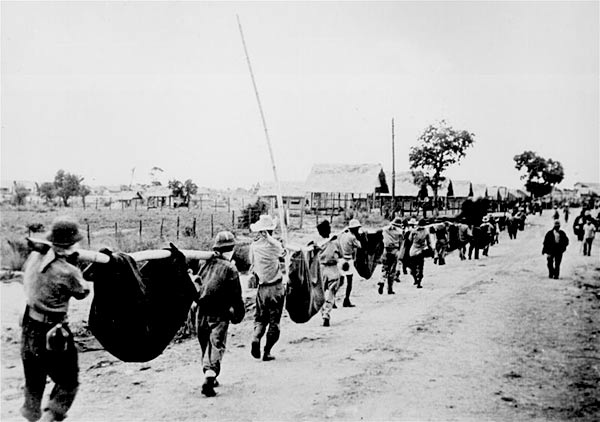Bataan Death March
Page 1
The Bataan Death March was a war crime involving the forcible transfer of prisoners of war, with wide-ranging abuse and high fatalities, by Japanese forces in the Philippines, in 1942, after the three-month Battle of Bataan, which was part of the Battle of the Philippines (1941-42), during World War II. In Japanese, it is known as Batan Shi no Koshin, with the same meaning.
The Fall of Bataan
On April 9, 1942, approximately 75,000 Filipino and United States soldiers, commanded by Major General Edward "Ned" P. King, Jr., were formally surrendered to a Japanese army of 50,000 men under Lt. General Masaharu Homma. This required Japan to accept emaciated captives who vastly outnumbered them. The Japanese, having expected the fighting to continue longer, had only expected 25,000 prisoners of war and did not have the facilities to properly care for them.
Logistics planning to move the prisoners of war from Mariveles to Camp O'Donnell, a prison camp in the province of Tarlac, was handed down to transportation officer Major General Yoshitake Kawane ten days prior to the final Japanese assault. The first phase of the operation, which was to bring all of the prisoners to Balanga, consisted of a nineteen mile march that was expected to take one day. Upon reaching Balanga, Kawane was then to take personal command of executing the second phase, which consisted of transporting the men to the prison camp. 200 trucks were to be utilized to take the prisoners 33 miles north to the rail center at San Fernando, where freight trains, which would move them another 30 miles to the village of Capas, awaited them. Upon reaching Capas, the prisoners were then to march an additional 8 miles on foot to Camp O'Donnell. Field hospitals were to be established at Balanga and San Fernando while various aid stations and resting places were to be set up every few miles.

PRISONERS ON MARCH FROM BATAAN TO THE PRISON CAMP, MAY 1942 - NATIONAL ARCHIVES
The Death March
Although General Homma and Kawane had expected only 25,000 prisoners of war, they were greeted by more than 75,000 (11,796 Americans and 66,000 Filipinos) starving and malaria-stricken captives at Bataan. During the battle, only 27,000 of these men were listed as "combat effective". Even then, three fourths of this number were still affected by malaria. As a result, the Japanese army met great difficulties in transporting these prisoners from the beginning. Equally, distributing food was almost impossible so many were fed nothing. 4,000 sick or wounded captives had to stay behind to be treated by the Japanese at Bataan. A shortage of manpower and supplies on the part of the Japanese, who were now laying siege to Corregidor, raised confusion and irritation amongst the guards as many prisoners escaped. At most, only 4 Japanese soldiers could accompany each group of 300 prisoners. The march to Balanga, which was to take only one day, lasted as long as three days for some soldiers.


